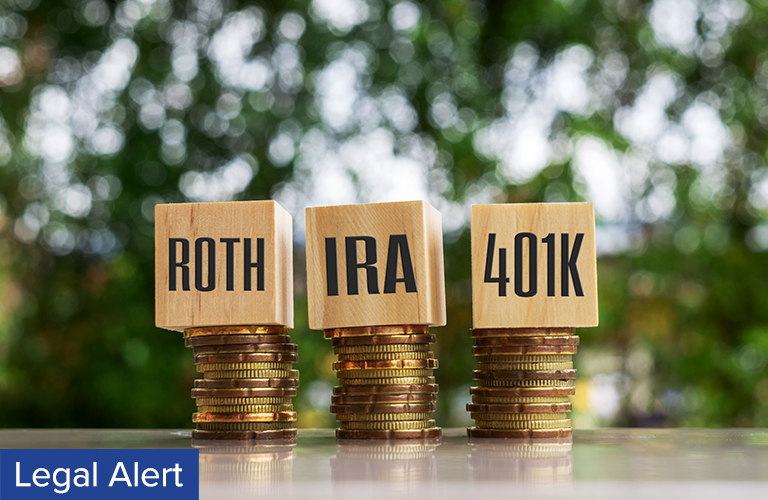
If you own an IRA or are a participant in a qualified retirement plan, such as a 401(k), and if your retirement benefits are a factor in your estate planning then the SECURE Act can have a significant impact on how your beneficiaries receive those benefits. Every dollar paid out of the IRA or retirement plan to your beneficiary is subject to income tax just as you are subject to income tax when you receive a distribution during your lifetime. The SECURE Act, which applies to IRA and most retirement plan distributions to beneficiaries of decedents dying after December 31, 2019, affects the timing of the income taxation of those distributions.
For those individuals who are leaving retirement benefits entirely to charity, you are not affected by the SECURE Act and need read no further; there is nothing you need to do.
I am leaving my IRA to my spouse at my death. How will my spouse be affected by the SECURE Act?
The SECURE Act did not change the way benefits are payable to a surviving spouse. A spouse may still rollover the benefits to his or her own IRA and the benefits can be paid to the surviving spouse over the spouse’s life expectancy.
If my spouse predeceases me, I have named my children as the beneficiaries of my IRA. Will they be affected by the SECURE Act?
Potentially. Prior to SECURE a beneficiary could take distribution over his or her life expectancy thus deferring the income tax payable on the plan proceeds. (Of course, the beneficiary was free to take distribution at any time and would pay the tax when the benefits were received.) Under SECURE, with certain exceptions, the plan benefits must be paid out by December 31st of the year that contains the 10th anniversary of the date of death (the “10-year rule”).
If your child is a minor, however, the beneficiary may take the benefits over his or her life expectancy and upon attaining majority (generally age 18 or 21 depending on state law) the 10-year rule will apply.
I don’t want my children to receive too much too soon, so what if the IRA proceeds are payable to trusts for them?
The use of a trust to receive retirement benefits raises a number of issues.
In order for a trust to be able to maximize the period over which benefits are paid, the trust must have a “designated beneficiary”[1]. If the trust has a designated beneficiary, it can take advantage of the 10-year rule.[2]
A trust which receives plan benefits may be designed as either a “conduit” trust or an “accumulation” trust. A conduit trust requires that any benefit withdrawn from the IRA must be paid from the trust to the beneficiary. An accumulation trust means that when the benefits are paid from the IRA they remain in the trust subject to the terms of the trust. In either event, subject to certain exceptions, all of the benefits must be paid out of the IRA in accordance with the 10-year rule.
I want my Trustee to decide if and when to pay trust funds to the beneficiary. Will an accumulation trust still work?
Yes, it will, but subject to certain exceptions, the benefits must be paid out of the IRA to the trust under the 10-year rule. The income tax payable on the receipt of the benefits will be required to be paid by the trust. A trust pays federal income tax at the highest income tax bracket. So since you can no longer use the life expectancy of the designated beneficiary to make smaller payments of the IRA over a longer period of time, the accumulation trust will result in substantially accelerating the income tax.
Note that if your beneficiaries themselves are in the top income tax bracket the fact that the trust is also in the top bracket may be not significant. Also, consider the impact of state income tax.
So whether outright or in a trust, my IRA or retirement plan benefits must generally be fully withdrawn from the plan in 10 years. How must distribution be made over the 10 years?
Distributions can be made at any time, from time to time, or not at all as long as all amounts are distributed by December 31st of the year that contains the 10th anniversary of the date of death.
You have mentioned exceptions to the 10-year rule, what are they?
The SECURE Act adds a category of beneficiaries referred to as “eligible designated beneficiaries” which are eligible for the payment of benefits over his or her life expectancy. The eligible designated beneficiaries are:
- The surviving spouse;
- A minor child of the decedent;
- A disabled individual;
- A chronically ill individual;
- A beneficiary less than 10 years younger than the decedent.
Any good news?
Yes, the SECURE Act increased the starting age for required minimum distributions from 70½ to 72. The Act also removed the age cap for contributions to a traditional IRA. Under prior law an individual could not contribute to an IRA after he or she attained age 70½.
So what should I do?
Now is a good time to review your beneficiary designations to make sure they are consistent with your estate plan and to determine if your retirement plan benefits will be distributed in the manner that works best for you and your beneficiaries.
[1] A designated beneficiary for this purpose is determined under IRS rules and generally means that all of the beneficiaries of the trust who may receive the plan benefits must be individuals, e.g., a charity is not a designated beneficiary.
[2] If there is no designated beneficiary, the plan benefits must be distributed over 5 years if the participant dies before his or her required beginning date (RBD), or if the participant dies on or after the participant’s RBD, over the participant’s remaining life expectancy.

